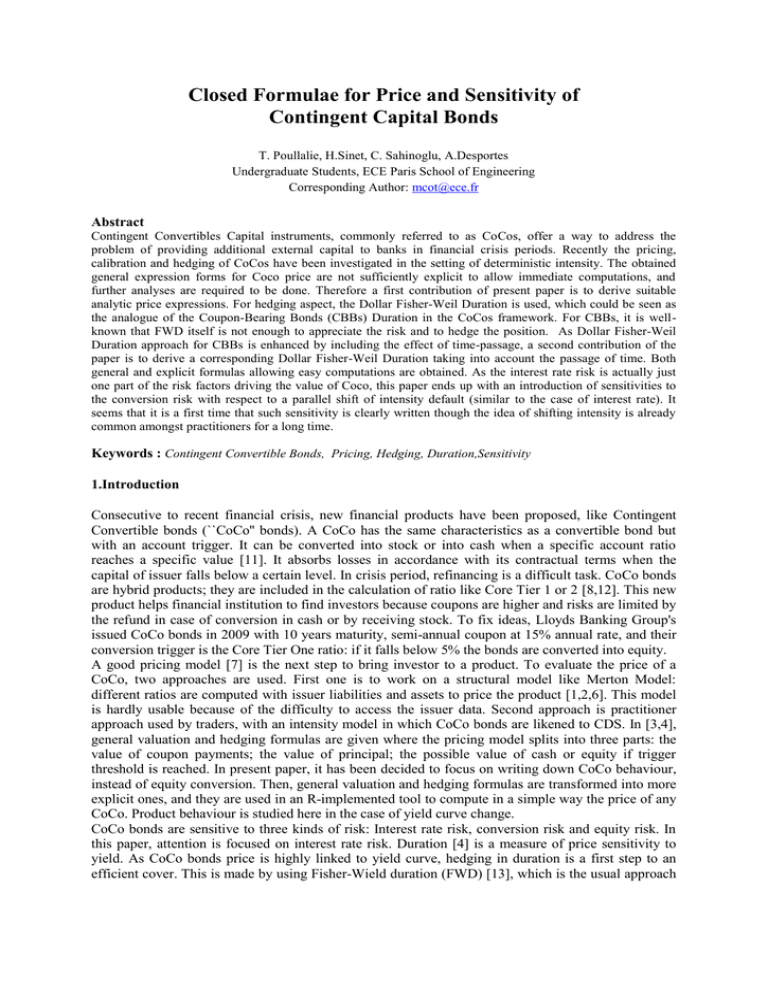Closed Formulae for Price and Sensitivity of Contingent Capital Bonds
advertisement

Closed Formulae for Price and Sensitivity of
Contingent Capital Bonds
T. Poullalie, H.Sinet, C. Sahinoglu, A.Desportes
Undergraduate Students, ECE Paris School of Engineering
Corresponding Author: mcot@ece.fr
Abstract
Contingent Convertibles Capital instruments, commonly referred to as CoCos, offer a way to address the
problem of providing additional external capital to banks in financial crisis periods. Recently the pricing,
calibration and hedging of CoCos have been investigated in the setting of deterministic intensity. The obtained
general expression forms for Coco price are not sufficiently explicit to allow immediate computations, and
further analyses are required to be done. Therefore a first contribution of present paper is to derive suitable
analytic price expressions. For hedging aspect, the Dollar Fisher-Weil Duration is used, which could be seen as
the analogue of the Coupon-Bearing Bonds (CBBs) Duration in the CoCos framework. For CBBs, it is wellknown that FWD itself is not enough to appreciate the risk and to hedge the position. As Dollar Fisher-Weil
Duration approach for CBBs is enhanced by including the effect of time-passage, a second contribution of the
paper is to derive a corresponding Dollar Fisher-Weil Duration taking into account the passage of time. Both
general and explicit formulas allowing easy computations are obtained. As the interest rate risk is actually just
one part of the risk factors driving the value of Coco, this paper ends up with an introduction of sensitivities to
the conversion risk with respect to a parallel shift of intensity default (similar to the case of interest rate). It
seems that it is a first time that such sensitivity is clearly written though the idea of shifting intensity is already
common amongst practitioners for a long time.
Keywords : Contingent Convertible Bonds, Pricing, Hedging, Duration,Sensitivity
1.Introduction
Consecutive to recent financial crisis, new financial products have been proposed, like Contingent
Convertible bonds (``CoCo'' bonds). A CoCo has the same characteristics as a convertible bond but
with an account trigger. It can be converted into stock or into cash when a specific account ratio
reaches a specific value [11]. It absorbs losses in accordance with its contractual terms when the
capital of issuer falls below a certain level. In crisis period, refinancing is a difficult task. CoCo bonds
are hybrid products; they are included in the calculation of ratio like Core Tier 1 or 2 [8,12]. This new
product helps financial institution to find investors because coupons are higher and risks are limited by
the refund in case of conversion in cash or by receiving stock. To fix ideas, Lloyds Banking Group's
issued CoCo bonds in 2009 with 10 years maturity, semi-annual coupon at 15% annual rate, and their
conversion trigger is the Core Tier One ratio: if it falls below 5% the bonds are converted into equity.
A good pricing model [7] is the next step to bring investor to a product. To evaluate the price of a
CoCo, two approaches are used. First one is to work on a structural model like Merton Model:
different ratios are computed with issuer liabilities and assets to price the product [1,2,6]. This model
is hardly usable because of the difficulty to access the issuer data. Second approach is practitioner
approach used by traders, with an intensity model in which CoCo bonds are likened to CDS. In [3,4],
general valuation and hedging formulas are given where the pricing model splits into three parts: the
value of coupon payments; the value of principal; the possible value of cash or equity if trigger
threshold is reached. In present paper, it has been decided to focus on writing down CoCo behaviour,
instead of equity conversion. Then, general valuation and hedging formulas are transformed into more
explicit ones, and they are used in an R-implemented tool to compute in a simple way the price of any
CoCo. Product behaviour is studied here in the case of yield curve change.
CoCo bonds are sensitive to three kinds of risk: Interest rate risk, conversion risk and equity risk. In
this paper, attention is focused on interest rate risk. Duration [4] is a measure of price sensitivity to
yield. As CoCo bonds price is highly linked to yield curve, hedging in duration is a first step to an
efficient cover. This is made by using Fisher-Wield duration (FWD) [13], which is the usual approach
for bonds. Following [5], its relevance will be discussed because FWD is a duration calculated at time
t = 0, and does not take into account the passage of time.
2. CoCos Pricing
2.1. Model Formula: The starting point is a model [1] to evaluate CoCo price PC(t) at a given time in
which the pricing expression is split into 3 parts :
PC(t) = C1(t) + C2(t) + C3(t)
(1)
First part C1(t) corresponds to the value of future coupon payments including accrued interest in case
of payment occurrence between two coupon times
∑
∑
∫
(2)
Second one C2(t) is principal value
(3)
Third one C3(t) corresponds to the value of possible conversion into equity shares or into cash
payment
(4)
∫
In (2,3,4) t is default intensity, t = ∫
, <P(t,T)> = P(t,T)expt) and P(t,T) is zero
coupon bond price at time t with maturity T. It can be observed that (2),(3),(4) require the evaluation
of only two integrals I0(t,T) = ∫
and I1(t,T) = ∫
∫
T
= sI0(t,s)|t ∫
from definition of s. Fixing
= h(s) > 0, there exist s =
H(s) the primitive of h(.), and an increasing monotonic one-to-one inverse function s = H1().
Evaluation of I0 and I1 may be easier in terms of when s-dependence of P is non transcendental,
reducing the integrals to a Laplace transform.
2.2. Closed Expressions: Previous expressions (2,3,4) being written with integrals, they cannot be
easily used in a pricer and should be first evaluated to obtain closed formulae easier to implement. A
first issue is that CoCo pays semi-annual coupons whereas, on the market, there are only ZC maturities
at particular periods of time, see Figure 1. The second issue is the value of deterministic jump intensity
λt [10]. This λt can be implicited from CDS liquidly traded on the market [9]. Here to keep the analysis
reasonable and simple enough, λt is assumed to be constant between two ZC maturities ie
t = k(k k1)(t tk)
(5)
so that calculation can be kept in s variable. Then, the pricing formula is split regarding the maturity T
with separated even and odd maturities until t = 20, see Table I.
Table I : ZC Bonds Maturity (T) Split along with CoCos (tk)
Letting from (5) λs be constant in each interval [Tk,Tk+1] between each maturity, zero coupon price will
be simply interpolated by the expression
P(t,s) = P(t,Tk1) exp[fk(s Tk1)]
(6)
with fk = (Tk Tk1)1log{P(t,Tk1)/P(t,Tk)} and Tk1 ≤ s ≤ Tk, supposing for simplicity that zero
coupon price is normalized to its value at time t = T0. Using (6), all integrals in (2),(3),(4) can be easily
performed and CoCo price PC(t) is obtained in each case considered in Figure 1b. Then each
component of PC(t) takes respectively the following form for odd index t2k+1
C11(t2k+1) = C11(t2k) + c2k+1k(t)E0(k+1,2k+1)
C12(t2k+1) = C12(t2k) c2k+1(k+1φk+1)k(t)E1(k+1,2k+1)
C2(t2k+1) = Fk(t)E0(k+1,2k+1)
C3(t2k+1) = C3(t2k) G(k+1φk+1)k(t){E0(k+1,2k+1) E0(k+1,2k)}
(7)
and similarly for even index t2k
C11(t2k) = C11(t2) + ∑
[c2i+1E0(i+1,2i+1) + c2i+2E0(k+1,2i+2)]
C12(t2k) = C12(t2) ∑
c2i+1E1(i+1,2i+1) + c2i+2E1(k+1,2i+2)]
C2(t2k) = Fk(t)E0(k,2k)
C3(t2k) = C3(t2) G∑
[E0(i,2i) E0(i,2i2)]
(8)
with C1(t) = C11(t) + C12(t), φi = i+ fi, k(t) = P(t,Tk)exp{fk+1Tk + 1t} and
E0(m,l) = exp{φmtl + tm1 + fmTm1}
E1(m,l) = [1+ M(m,l)] exp{φmtl} m,l exp{φmtl1}
tm = ∑
(j+1 j) t2m+1m+1
m,lφm(tl tl1)]1
First coefficients are
C1(t1) = c1F1C2(t1) c1(1(t1)E1(1,0) ; C2(t1) = F0(t1)E0(1,0)
C3(t1) = G0(t1)E0(1,0) ; C1(t2) = C1(t1) + c20(t2)E0(1,0) c20(t2)E1(1,2)
C2(t2) = F0(t1)E0(1,0) ; C3(t2) = G0(t1)[ exp{φ1t2} exp{φ1t1}]
(9)
(10)
3. Pricing Results
From (1-10) CoCo price can be calculated for different maturities, and effect of its three contributions
can be analyzed. Figure 2 shows price decomposition into each leg (coupons, principal and cash
payment). It is observed that the principal is decreasing whereas maturity increases as a consequence
of nominal actualization. The coupon leg is increasing with maturity, as it is a sum of actualized cash
flows. These observations reinforce CoCo bond characteristics.
Figure 2: Coco Price Decomposition vs Maturity
Figure 3: Coco Price for Different Coupon Value vs Maturity
(4) shows that cash payment leg is function of a zero-coupon bond and a default intensity probability.
Considering that the refund ratio is actualized by the zero-coupon bond, the value of this term should
decrease with time. However, cash payment leg slightly rises with time, indicating that default
intensity increases with maturity, and has more impact on CoCo value than zero-coupon price.
Figure 3 shows the effect of coupon value on Coco price regarding maturity. Here the actualized sum
of coupons is driving CoCo price growth. It can be assumed that default intensity absorbs coupon
actualization. For the same maturity, CoCo price is linearly sensitive to a shift in lambda or to risk-free
rate. If default intensity or risk-rate increases, the holder of a CoCo is losing money, and is winning in
opposite situation. From Figure 4 it appears that CoCo price is twice more impacted by a shift in
(default intensity) than by a risk-free rate shift, confirming the importance of default intensity in CoCo
pricing.
Figure 4: Price Impact of and of Risk-Free Rate Shifts
As mentioned earlier, attention is here focused on CoCo bonds sensitivity to interest rate risk.
Duration [4] is a measure of price sensitivity to yield, and as CoCo bonds price are highly
linked to yield curve, hedging in duration is a first step for an efficient cover. This is made by
using Fisher-Wield duration (FWD), which is the usual approach for bonds.
3. Sensitivity Analysis
3.1. Fisher-Weil Duration:
Very similar to CoCo price, FWD can be expressed as the sum of three terms
FWDC(T) = DC1(T) + DC2(T) + DC3(T)
(11)
where
∑
∑
∫
= (Tt)
∫
(12)
(13)
(14)
with previous definitions. Calculations for general function
= h(s) > 0 are now implying the
evaluation of I0(t,T) = ∫
, I1(t,T) = ∫
=
∫
sI0(t,s)|tT ∫
and I2(t,T) = ∫
= s2I0(t,s)|tT I1(t,T), which reduces to the
first two ones. For specific piecewise constant dependence of t, it is easily verified that moreover
DCj(T) = Ij1(t,T)/ Breaking DC1(.) = DC11(.) + DC12(.) as for C1(.), main difficult part is second
term which respectively writes
DC12(t2k) = (k+1φk+1)k(t)Ψk(t, φk)
DC12(t2k+1) = c2k+1(k+1φk+1)k(t)[t2k+1 t2k]{Ψk(t, φk+1) Ψk+1(t, φk+1)}
(15)
for even and odd time index, and where Ψk(t, φk) = exp(φkt2k)[tt0+(t+t0)(t2k+ φk(t2k+ φk φk
Other terms are not given here. Figure 7 shows that CoCo duration is almost following zero-coupon
bond duration used for pricing. This is why the duration value is between 0 and 7 years. Then a
parallel shift is introduced in the risk-free rate. First order approximation of CoCo Profit and Losses
(PL) is computed by multiplying previous FWD value by the shift see Figure 6. To discuss the
accuracy of this approximation it is compared to CoCo real PL, see Figure 6. It is given by pricing the
CoCo with the zero-coupon price modified by shifted rate curve. PL first order approximation is
slightly higher than CoCo one. FWD sensitivity brings some error in computation of approximate PL.
This error called Error1 is included between 0 and 0.6% in absolute value.
Figure 7: Rate 1rst Order Sensitivity
Approximation at Time t and with at t=0
Figure 6: PL and FWD vs ε
Error1, equal to the difference between PL and FWD, is now compared to error of first order
sensitivity approximation considering passage of time in order to prove that present approach is more
logical and more accurate.
3.2. First order sensitivity approximation
To improve accuracy of present CoCo sensitivity approximation, the sensitivity is introduced.
Durations are determined in years and time t is taken into consideration in their computation.
In Figure 7, it is seen that duration is below rate duration. An explanation can be that CoCo price, as
previously seen, is more impacted by shift than by rate shift, which means that shift impacts the
price on shorter maturities. One can notice the existence of jumps in curve. They are due to the high
CoCo sensitivity to default intensity, and the fact that has been taken as constant between ZC
maturities. As previously, a parallel shift is taken in the risk-free rate and in . Then the first order
approximation of CoCo PL at time t=0 is computed by multiplying previous rate and duration value
by the shift see Figure 7. To discuss the accuracy of this approximation, it is compared with CoCo
future value with a shift at time t, see Figure 8. The closed formula for sensitivity and future Coco
value are given in [9]. PL first order approximation is almost the same as PL evaluated with CoCo
future value. Difference between both curves is giving Error2, see Figure 8. This error is included
between 0 and 0.03% in absolute value.
Figure 8: 1rst Order Sensitivity Approximation and
PL vs ε
Figure 9: 1rst Order Sensitivity Approximation and
PL vs ε for t=150 Days
Figure 10: Difference between Error1 and Error2
vs
Figure 11: Difference between Error1 and Error2 at t=150
Days
As present analysis is aimed at showing the effect of time passage in first order sensitivity, the same
computation has been done for time t=150 days. In Figure 9, the term called Sensi_0 representing the
difference between initial price and price at time t is introduced. Sensi_0 shows the effect of time
passage on price without any shift. This term is added to Sensi_1 representing sensitivity in and rate,
to fit in a more realistic way the future value of CoCo PL. It is observed that Error2 is increasing with
t=150 days, so time effect on error seems to be correct. One can also see that sensitivity term gives
now an over evaluated PL approximation.
3.3 Discussion of Errors: If Error1 and Error2 are compared at time t=0, first order sensitivity
approximation including passage of time and sensitivity is very small and reasonably compares to
Error1, see Figure 10. Error2 shows that in this approach the CoCo PL is not over evaluated.
Concerning Error2 at 150 days, it appears that, even if it is an extreme scenario, Error2 is not far from
Error1, see Figure 11. It can be deduced that in this case present approach is still viable.
In Figure 12, the difference between Error1 and Error2 vs time t in a range [0,150] and vs the shift is
plotted. From this figure it is noticed that Error2 is inferior to Error1 from t=0 to t=90, and becomes
superior for t > 90. It is shown that taking into consideration passage of time and sensitivity is a
good approach for study of CoCo first order sensitivity and, consecutively, it is expectable that using
this approach to hedge CoCo is more accurate.
Figure 12: Difference between Error1 and Error2 function of t in days
4. Conclusion
According to obtained results, CoCo prices are behaving like bond products. Nevertheless, the default
characteristic of this product is a really important point. When plotting the effect of a shift in and a
shift in rate on CoCo price, it is shown that CoCo is two times more impacted by a shift in . To show
this point is important in terms of Profits and Losses. Effectively it can be deduced that hedging this
market parameter is really important for practitioners. This is why in Part 3 a way to compute the first
order sensitivity of the product to a shift in has been introduced. This sensitivity can be seen as
duration in and the value is in years as a Fisher-Weil Duration. This expression can help
practitioners to enhance their CoCo hedging by finding out the quantity and the nature of CDS which
fit the best. In a second part a new approach of CoCo first order sensitivity to a shift in rate curve has
been worked out. Main contribution is to point out the incorrectness in considering that the shift
happens at a time t = 0. Profit and Loss, as well as sensitivity, should be computed at horizon t. In this
way it is possible to appreciate the effect of time passage on the price and on sensitivity regarding a
shift. The comparison of DFW and the approximation with time passage consideration showed that the
second gives more accuracy in position cover. However, only first order sensitivity has been
considered here. Second order sensitivity which can help to hedge the convexity of CoCo to a shift in
rate curve has not been discussed. To prove the efficiency of present methods, the result of second
order approximation should also be studied. Moreover, it would be interesting to introduce a second
order sensitivity to a shift in lambda, to see how it impacts hedging accuracy.
Aknowledgments
The authors are very much indebted to ECE Paris School of Engineering for having provided the
environment where the work has been developed, Dr Y. Rakotondratsimba for useful comments and
Pr M. Cotsaftis for help in preparing the manuscript.
References
[1] S. Avdjiev A. Kartasheva, B. Bogdanova : (2013), CoCos: a Primer, BIS Quarterly Review, pp.43-56, Sept.
2013; B. Albul, D.M. Jaffee, A. Tchistyi : Contingent Convertible Bonds and Capital Structure Decisions,
Coleman Fung Risk Management Research Centre, Working Paper #2010-01, 2010
[2] J.M. Corcuera, J. De Spiegeleer, A. Ferreiro-Castilla, A.E. Kyprianou, D.B. Madan : Efficient Pricing of
Contingent Convertibles under Smile Conform Models, J. Credit Risk, Vol.9(3), pp.129-140, 2013
[3] P. Cheridito, Z. Xu : Pricing and Hedging CoCos, 2013, SSRN.com,
[4] P. Cheridito, Z. Xu : A Reduced Form CoCo Model with Deterministic Conversion Intensity, SSRN.com,
2013
[5] H. Jaffal, Y. Rakotondratsimba, A. Yassine : Hedging with a Portfolio of Interest Rate Swaps, Comm. Math.
Finance, Vol.2(1), pp.19-64, 2013.
[6] S. Wilkens, N. Bethke : Contingent Convertible (’CoCo’) Bonds: A First Empirical Assessment of Selected
Pricing Models, Financial Analysts Journal, Vol.70(2), pp.59-77, 2014
[7] J. De Spiegeleer, W. Schoutens : Contingent Convertible (CoCo) Notes: Structure and Pricing. Euromoney
Books, 2011.
[8] E. Barucci, L. Del Viva : Dynamic Capital Structure and the Contingent Capital Option, Annals of Finance,
Vol.9(3), pp.337-364, 2013.
[9] D. O'Kane, S. Turnbull : Valuation of Credit Default Swaps, Lehman Brothers, Fixed Income Quantitative
Credit Research, 2003.
[10] J. Pan, K. Singleton : Default and Recovery Implicit in the Term Structure of Sovereign CDS Spreads, J.
Finance , Vol.63, pp.2345-2384, 2008.
[11] P. Bolton, F. Samama : Capital Access Bonds: Contingent Capital with an Option to Convert, Economic
Policy, Vol.27(70), pp.275-317, 2012.
[12] J. de Spiegeleer, W. Schoutens : Pricing Contingent Convertibles: a Derivatives Approach, J. Derivatives,
Vol.20(2), pp.27–36, 2012; V.G Veiteberg, F.T. Bysveen, B.H. Rosef : Pricing Contingent Convertible Capital :
An Empirical Approach, Dept of Industrial Economics and Technology management, Norwegian University of
Science and Technology, Trondheim, Norway, 2012.
[13] A. Jeffrey : Duration, Convexity and Higher Order Hedging (revisited), Yale School of Management,
Working Paper, 2000




